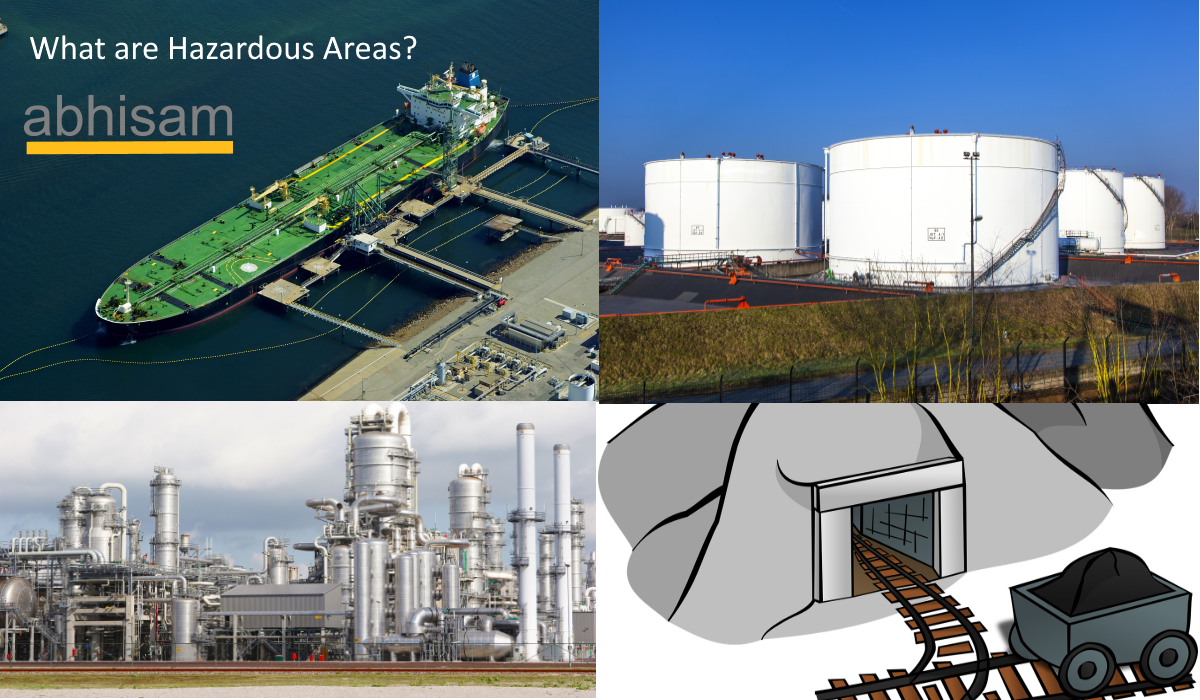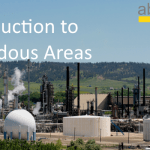What is a Hazardous Area?
A Hazardous Area is a place where there is a risk of explosion and/or fire due to the nature of the materials handled or stored there. In the US, these areas are also known as classified locations. Note that “Hazardous Area” is a technical term used in industry and not a generic word that can be used for any dangerous place, such as crime infested neighborhood.
Hazardous areas examples
As you can guess, these hazardous areas can be found in places such as chemical manufacturing plants, chemicals storage areas, oil terminals, oil and gas fields, petroleum refineries, tank farms or similar industrial facilities. These materials can be flammable or explosive or both and can include hydrocarbons such as Acetone or Methane or Natural Gas.
However, it is not just volatile hydrocarbons or chemicals that can explode or catch fire. There are many other materials such as cotton fibers, metal dusts, coal dust, flour or even sugar dust that can be explosive. Hence the areas that have large quantities of these materials are also classified as hazardous areas.
Why are hazardous areas considered hazardous?
A single spark can ignite a hazardous vapor/air mixture and cause an explosion or fire or both, which can lead to loss of life and property, as well as consequential damages to the environment that may happen due to loss of containment of the storage tank or vessel that contained the material. Thus it is very important to prevent ignition in hazardous areas. It takes a ridiculously less amount of energy to ignite some gas/air mixtures. For example it takes only a few millijoules to ignite a Hydrogen-air mixture.
What steps can we take to make hazardous areas safer?
Every year, there are reports of many accidents and fatalities that happen in hazardous areas. The first step of making hazardous areas safer is by making people aware of the hazards.We need to do the following to make hazardous areas safer.
1. Carry out a Hazardous Area Classification. In this exercise, you need to classify hazardous areas by the degree of the hazard that is present in them and divide them into Zones (in the EU and in the Rest of the world) or into Divisions (in the US). Then we can better understand which areas need what kind of equipment and precautions for this particular area. To know how to do this you can take the Abhisam Hazardous Area Classification course.
2. We need to select equipment that is suitable for use in that particular Zone or Division. This means all equipment must be of the “explosion protected type”. (Note: “Explosion protected” does not equal explosionproof. The explosionproof technique is just one of the protection techniques that can be used to build explosion protected equipment. There are others such as Increased Safety, Intrinsically Safe, Pressurization, etc)
Thus ensure that all equipment that is used in hazardous areas should be suitable for use in these areas. You cannot use general purpose equipment. For example when you use Instrumentation in hazardous areas, you need to use only hazardous area instrumentation. Ditto for other equipment like motors or junction boxes. To know more about this please take the Abhisam Hazardous Area Instrumentation Course. If you wish to use Intrinsically Safe equipment (this is a type of technique that prevents instrumentation from discharging ignition capable energy into a hazardous area) you can take the Abhisam Intrinsic Safety Course.
3. We need to regularly inspect the installed equipment to verify that it continues to be safe to use in that particular Zone or Division.
4. We need to carry out operations and maintenance in these areas that will not cause an accident. This means ensuring that the area is free of hazardous gases and dusts before carrying out hot work, having a permit system in place and continuous monitoring of leaks.
If you have no idea about the basics of this subject, then you can start by taking the Abhisam free hazardous area training course.
Rules Regulations & Standards
To prevent accidents and damage to life and property, there are several rules and regulations that cover these areas. These are different in different countries and jurisdictions. The terminology is also different. For example in the European Union, we have ATEX (short for Atmosphere Explosive) and these are called as ATEX Directives. These cover both the owners of facilities as well as the equipment suppliers that provide equipment to these facilities. Contrary to what many people assume these rules not only cover electrical and electronic equipment, but also mechanical equipment.
In the US, the National Electrical Code has sections that deal with electrical installation in hazardous areas.
Most of the rest of the world follows their own country level rules that are based on International Standards such as IEC 60079 series of standards that cover this. In this system, we have hazardous area classification zone 0, 1 & 2.
IEC stands for the International Electrotechnical Commission and has more than 80 countries as members. The US is also a member and slowly the US will harmonize its rules to be more in line with the IEC standards.
Where can I get more information ?
You can take any of Abhisam’s courses such as Hazardous Area Classification, Hazardous Area Instrumentation, Intrinsic Safety and others.


